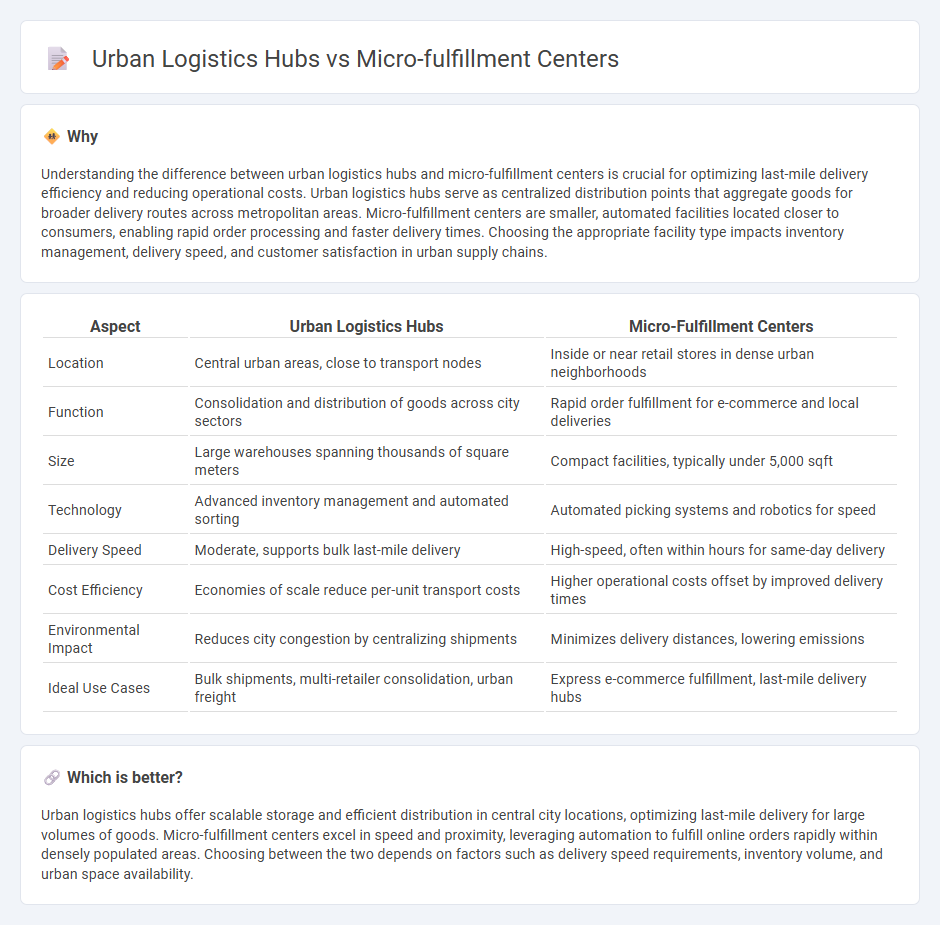
Urban logistics hubs serve as centralized distribution points designed to streamline the flow of goods in densely populated areas, reducing delivery times and traffic congestion. Micro-fulfillment centers utilize automated technology within small, strategically located facilities to enable rapid order processing and last-mile delivery efficiency. Explore more to understand how these solutions are transforming supply chain dynamics in metropolitan regions.
Why it is important
Understanding the difference between urban logistics hubs and micro-fulfillment centers is crucial for optimizing last-mile delivery efficiency and reducing operational costs. Urban logistics hubs serve as centralized distribution points that aggregate goods for broader delivery routes across metropolitan areas. Micro-fulfillment centers are smaller, automated facilities located closer to consumers, enabling rapid order processing and faster delivery times. Choosing the appropriate facility type impacts inventory management, delivery speed, and customer satisfaction in urban supply chains.
Comparison Table
| Aspect | Urban Logistics Hubs | Micro-Fulfillment Centers |
|---|---|---|
| Location | Central urban areas, close to transport nodes | Inside or near retail stores in dense urban neighborhoods |
| Function | Consolidation and distribution of goods across city sectors | Rapid order fulfillment for e-commerce and local deliveries |
| Size | Large warehouses spanning thousands of square meters | Compact facilities, typically under 5,000 sqft |
| Technology | Advanced inventory management and automated sorting | Automated picking systems and robotics for speed |
| Delivery Speed | Moderate, supports bulk last-mile delivery | High-speed, often within hours for same-day delivery |
| Cost Efficiency | Economies of scale reduce per-unit transport costs | Higher operational costs offset by improved delivery times |
| Environmental Impact | Reduces city congestion by centralizing shipments | Minimizes delivery distances, lowering emissions |
| Ideal Use Cases | Bulk shipments, multi-retailer consolidation, urban freight | Express e-commerce fulfillment, last-mile delivery hubs |
Which is better?
Urban logistics hubs offer scalable storage and efficient distribution in central city locations, optimizing last-mile delivery for large volumes of goods. Micro-fulfillment centers excel in speed and proximity, leveraging automation to fulfill online orders rapidly within densely populated areas. Choosing between the two depends on factors such as delivery speed requirements, inventory volume, and urban space availability.
Connection
Urban logistics hubs streamline the flow of goods by serving as central points for storage and distribution within densely populated areas. Micro-fulfillment centers, strategically integrated within these hubs, enable rapid order processing and last-mile delivery by utilizing automation and proximity to consumers. This connection enhances supply chain efficiency, reduces transportation costs, and supports sustainable urban mobility solutions.
Key Terms
**Micro-fulfillment Centers:**
Micro-fulfillment centers are compact, automated warehouses located close to urban customers, designed to accelerate order fulfillment for e-commerce and retail businesses by utilizing advanced robotics and AI-driven inventory management. These centers drastically reduce delivery times and transportation costs while optimizing last-mile logistics in dense metropolitan areas. Explore how micro-fulfillment centers are transforming urban supply chains and enhancing customer satisfaction.
Automation
Micro-fulfillment centers leverage advanced robotics and AI-driven automation to expedite order processing and reduce last-mile delivery times in densely populated urban areas. Urban logistics hubs integrate automated sorting systems and real-time data analytics to optimize inventory management and streamline distribution networks across metropolitan regions. Explore the future of urban supply chain efficiency by learning more about automation in these innovative logistics solutions.
Last-mile delivery
Micro-fulfillment centers optimize last-mile delivery by leveraging automated storage and rapid order processing within urban retail spaces, significantly reducing delivery times. Urban logistics hubs serve as centralized distribution points that manage diverse transport modes and consolidate shipments, enhancing efficiency in high-density cities. Explore how these innovations reshape urban last-mile logistics for faster, cost-effective delivery solutions.
Source and External Links
Micro-Fulfillment Explained: Key Benefits and Strategies for Ecommerce Success - Micro-fulfillment centers are small warehouses (3,000 to 10,000 sq ft) positioned close to consumers in urban areas to enable faster, more efficient order fulfillment, significantly reducing last-mile delivery time and costs while improving inventory management and customer satisfaction, especially in grocery retail.
Micro-Fulfilment: In-Depth Guide + 7 Real Examples - Micro-fulfillment centers support rapid same-day order fulfillment through a hyper-local and vertically integrated model, with companies like Gopuff and Shoprite using them to improve service speed, operational capacity, and customer convenience including home delivery and curbside pickup.
Walgreens to increase stores serviced by micro-fulfillment centers - Walgreens is rapidly expanding the number of stores served by its micro-fulfillment centers to nearly 6,000 by improving operational efficiency and cost-effectiveness, after a pause to optimize its existing facilities, demonstrating the strategic importance of micro-fulfillment in retail pharmacy supply chains.
 dowidth.com
dowidth.com